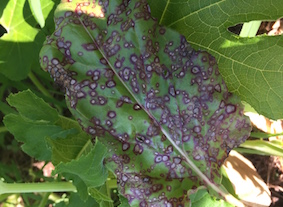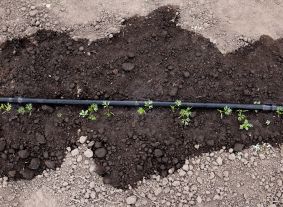Cercospora Leaf Spot on Swiss Chard
Views: 10361

I’ve written here before about the dreaded Cercospora. If you are not familiar with it, Cercospora is the cause behind the lovely leaf pattern (I’m being facetious) in the photo, aptly named cercospora leaf spot. If you couldn’t tell behind all those spots, that is a Swiss chard leaf. Not very appetizing, is it?
I will tell you how I dealt with this cercospora leaf spot outbreak in a moment. First, I’ll give you a quick rundown of what it is.
What Is Cercospora?
Cercospora leaf spot of beets, Swiss chard and spinach is caused by the fungus Cercospora beticola. Note that C. beticola causes leaf spots on species within the Chenopodium group only—basically your beets and chards and spinaches. I’ve had other cercospora leaf spots on celery and carrots but that is caused by another Cercospora species. I know, right?? I feel like cercosporas are everywhere!
The symptoms are small leaf spots with a pale brown center and a red ring. These circles can merge and because crusty in the center. Since it is a fungus, the fungus creates spores, which can easily spread by splashing water (irrigation, rain or general dampness) or via spores on tools. I read that those spores can infect the plants by simply floating themselves through open stomates on a leaf! Pretty amazing.
Cercospora loves high humidity and temperatures between 75-85F—exactly the conditions we’ve been experiencing in New England this summer. Once a cercospora infection hits, it’s only a matter of time before it will wipe out the crop. No one wants to eat chard that looks like this! For beets, where you could at least harvest the beets and discard the leaves, the cercospora leaf spot causes the beets to be undersized. But at least you can harvest something.
How to Recover Your Harvest After Cercospora
How I ended up with a cercospora leaf spot outbreak as bad as you see in the photo is simple. I noticed the tiny spots and I thought, “Oh, I think that is cercospora—I’ll keep my eye on that and take care of it later.” I kept putting off the time when I could have harvested the chard with minimal spots—it’s not going to hurt you if you eat a few spots, right? And by the time I got around to taking care of the leaf spot issue, most of my leaves were beyond salvageable.
But here’s the good news. Plants like beets, chard and spinach grow new leaves from the center. Those newer leaves don’t emerge with the leaf spots—it takes time for them to get the disease. I cut all of the chard down to about an inch above the root, sorted through the leaves and kept the leaves that were not (or barely) infected. I placed the leaves covered with Cercospora Leaf Spot into a plastic bag and took to the trash can. Also, I bagged up all the leaf debris that was sitting on the ground. Putting them in the compost would only let them happily overwinter near my plot so they could infect my crops again next season.
Now remember, this chard grows new leaves from the center. It’s been about 10 days since I chopped all the leaves off and new leaves are already emerging—spot free! I’m sure spots will arise, but I can at least get a few more rounds of leaves emerging, and I’ll just harvest them at a smaller size.
What compelled me to finally do that first harvest? Because I had a second row of chard nearby that I knew would succumb to leaf spot if I didn’t do something about the first crop. I didn’t want to lose everything!
Meet Ellen Wells
When you’re raised on a farm, you can’t help but know a thing or two about gardening. Ellen Wells is our expert on edible gardening.…
Ellen's Recent Posts

Asparagus






